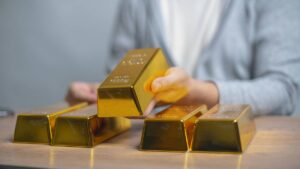Why Australia’s rare earths industry needs an ‘Elon Musk’

Pic: Bloomberg Creative / Bloomberg Creative Photos via Getty Images
ASX rare earths players are still struggling to make investors understand the potential of their industry.
If only Tesla boss Elon Musk could do for rare earths what he did for lithium.
“We’d like to have an Elon Musk represent our industry,” George Bauk, the boss of Australia’s newest heavy rare earths producer, Northern Minerals (ASX:NTU), quipped on a tour of the company’s Browns Range heavy rare earths project earlier this week.
“One of the things from a junior perspective is that the weakest thing we have is our balance sheets… This industry could probably accelerate and move forward a lot quicker if companies with better balance sheets were developing the projects.”
The two biggest moves in rare earths this year have been Australian heavyweight Wesfarmers (ASX:WES) lobbing a $1.5bn bid for major producer Lynas (ASX:LYC), and China threatening to stop sending its rare earth products to the US.
Both of these have put rare earths in the spotlight and seen investor interest in the space pick up, as well as prices head north.
“One thing that has been positive is that you’ve got a seriously large organisation wanting to invest in rare earths,” Bauk said about Wesfarmers.
Picking winners
Rare earths also needs “winners” to spur interest.
“My aspiration is for Lynas to just kick goals and make shitloads of money,” Bauk said.
“That’s my dream, because then I just park myself behind them and I sail forward because you need to have winners.
“You have an industry and no winner, why would you back the industry?
“That’s our biggest issue. When Molycorp went broke and Lynas was on its knees, why would you go into the rare earths space. There’s no commercial interest in the space.”
Light v heavy
Rare earths are a group of 17 metal oxides that are actually more common than gold or silver. Heavy rare earths have a higher atomic weight than light rare earths.
Late last year, heavy rare earth dysprosium was labelled the “dark horse in the rare earth stakes” by New York investment bank Hallgarten and Company as the rapid growth in the electric vehicle market spurs higher projections for demand.
It’s an additive used in the permanent magnets required for the motors in electric vehicles, with each one containing roughly 100 grams of dysprosium.
Dysprosium reduces the weight requirement and allows operation at very high temperatures.
The dysprosium price spiked 50 per cent since the start of this year, according to Bauk.
Of the light rare earths, there has been a lot of interest around neodymium-praseodymium (NdPr), which is used to make ultra-strong permanent magnets for micro-motors and the drivetrains of electric vehicles.
Global consumption of rare earths reached 137,000 tonnes of total rare earth oxides (TREO) in 2018 and is forecast to increase to 196,000 tonnes by 2030.
Demand for NdPr is forecast to outstrip supply within the next five years, possibly as early as 2020, according to Adamas Intelligence.
Last year China produced around 80 per cent of global NdPr supply and is estimated to account for 85 per cent of consumption.
As a result of the Asian behemoth’s growing NdPr needs, it is forecast to become a net importer by 2022.
Buyer interest takes off
Constrained supply and a lack of new projects is creating extra interest in new sources of rare earths.
“The interest has definitely escalated,” Northern Mineral’s Bauk said.
“People are unquestionably concerned about the short-term continuity of supply to China. We are a natural short-term conversation for the heavies because there are very small amounts of supply of it.
“If we were separating it, I think the conversations would be at another level up because we would have product they really want.
“It’s a frustrated product because you’re not producing exactly what the industry wants, but they still want to know how they can secure it.”
Bauk was referring to splitting the various heavy rare earths and selling them individually rather than selling them as just a combined heavy rare earth carbonate.
Nothing happens when there’s no news
Since the pick-up in rare earths interest, Lynas revealed it had inked an MoU to look at rare earths separation in the US.
Northern Minerals’ also wants to eventually undertake rare earths separation and previously negotiated a deal under which the US government had agreed to pay half the cost of shipping and testing product in the US for separation.
But the problem for the rare earths industry as a whole, is getting investors to understand it and invest more in it, even when big geopolitical events are not driving the market.
“One of the complexities we face is it’s not a simple thing to value because you’ve got more than one element,” Bauk explained.
“People that have got copper-gold projects normally use the copper as a credit and they offset their operating costs to make it a bigger margin etc and that tries to make people have a simpler way to analyse that project if you like.
“The problem you’ve got with rare earths is it’s an opaque market, so straight away people are concerned about that aspect.
“It’s hard to predict the future price. China dominates the product, so they control pricing.”
- Subscribe to our daily newsletter
- Join our small cap Facebook group
- Follow us on Facebook or Twitter
Bauk said the main issue is keeping the rare earths story simple.
“People’s bandwidth for attention is getting smaller and smaller,” he said.
“So I’ve got to be careful that my answer doesn’t last 22 minutes and people are sitting there going ‘I’ve lost you George and what was that element?’
“It is a complex story, so we’ve got to keep working to make it simple.”
Rare earths moves
In the heavy rare earths space, there are just two producers outside of China: Lynas and Northern Minerals.
Vital Metals (ASX:VML) announced this week though that it was breaking into the light and heavy rare earths space with a deal to buy private company Cheetah Resources.
Cheetah is a business run by a former manager of Lynas, Geoff Atkins.
The company has agreements in place to acquire two rare earth oxide projects, with Thor Lake in Canada and Wigu Hill in Tanzania for about $8.4m.
Thor Lake hosts light and heavy rare earths, while Wigu Hill hosts just light rare earths.
Cheetah’s plan though is not to go down the separation path, so it can save money and get into production quicker.
The news spurred Vital Metals shares up nearly 31 per cent.
Last week Krakatoa Resources (ASX:KTA) announced it was picking up a rare earths project in Western Australia that was once explored by heavyweight BHP (ASX:BHP).
That news sent shares up as much as 65 per cent.
This week Krakatoa told investors it was expanding the Mt Clere project via the lodgement of a new exploration licence application for an extra 153 sq km.
Meanwhile, the Western Australian Environmental Protection Authority has this week recommended Hastings Technology Metals’ (ASX:HAS) Yangibana NdPr project for approval.
Hastings says it is on track to start construction of the project this year subject to final finance arrangements.
The company plans to produce a mixed rare earths carbonate that will be separated into individual rare earth oxides overseas.
Arafura Resources’ (ASX:ARU) Nolans project in the Northern Territory will also produce NdPr.
Earlier this year Arafura released a definitive feasibility study for the project and has been in talks with potential customers at all points in the e-mobility supply chain in Europe, South Korea, China and Japan.
Arafura has seen some nice share price appreciation compared to others, with the price climbing 162 per cent since the start of the year and 81 per cent in the past month.
Alkane Resources (ASX:ALK) wants to bring its Dubbo rare earths project into production, but first needs to lock in buyers for its end product.
Managing director Nic Earner told Stockhead last month that the China-US tiff was exactly what the company needed to propel its project forward.
Alkane owns all the land, has completed all the engineering and pilot plant work, has locked in all the necessary mining and environmental licences and just needs to press the go button.
“So we need some of this trade, China environmental concerns, we need that to land and for the investment community to make a decision where it’s moving in order for us to get the required offtake and subsequent investment in that project,” Earner said.
Alkane’s share price has run 133 per cent since January and is up 72 per cent over the past month.
Greenland Minerals & Energy (ASX:GGG) has a light and heavy rare earths project in Greenland.
The company is getting a lot closer to permitting and also has a big Chinese partner, Shenghe Resources — which has an 11 per cent stake.
Greenland’s Kvanefjeld project is expected to be one of the largest producers globally of key magnet metals including neodymium, praseodymium, dysprosium and terbium, along with by‐production of uranium and zinc, for nearly 40 years.
The company’s share price has more than doubled since the start of 2019 and has climbed 43 per cent over the past month.
UNLOCK INSIGHTS
Discover the untold stories of emerging ASX stocks.
Daily news and expert analysis, it's free to subscribe.
By proceeding, you confirm you understand that we handle personal information in accordance with our Privacy Policy.








